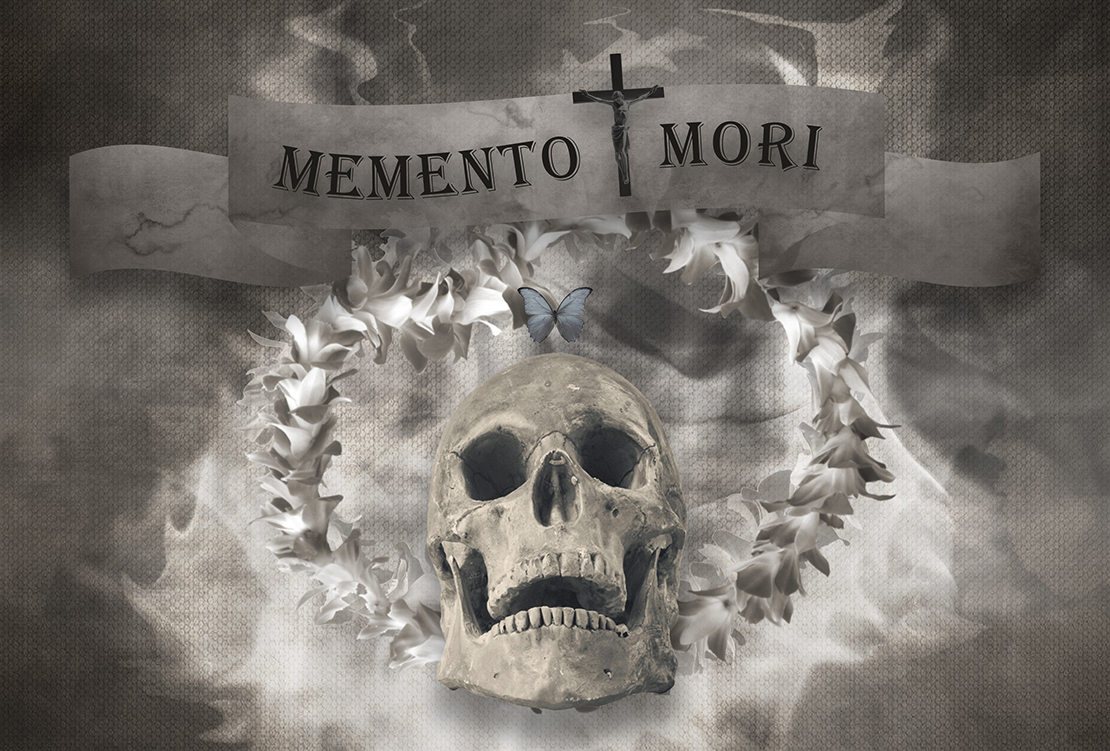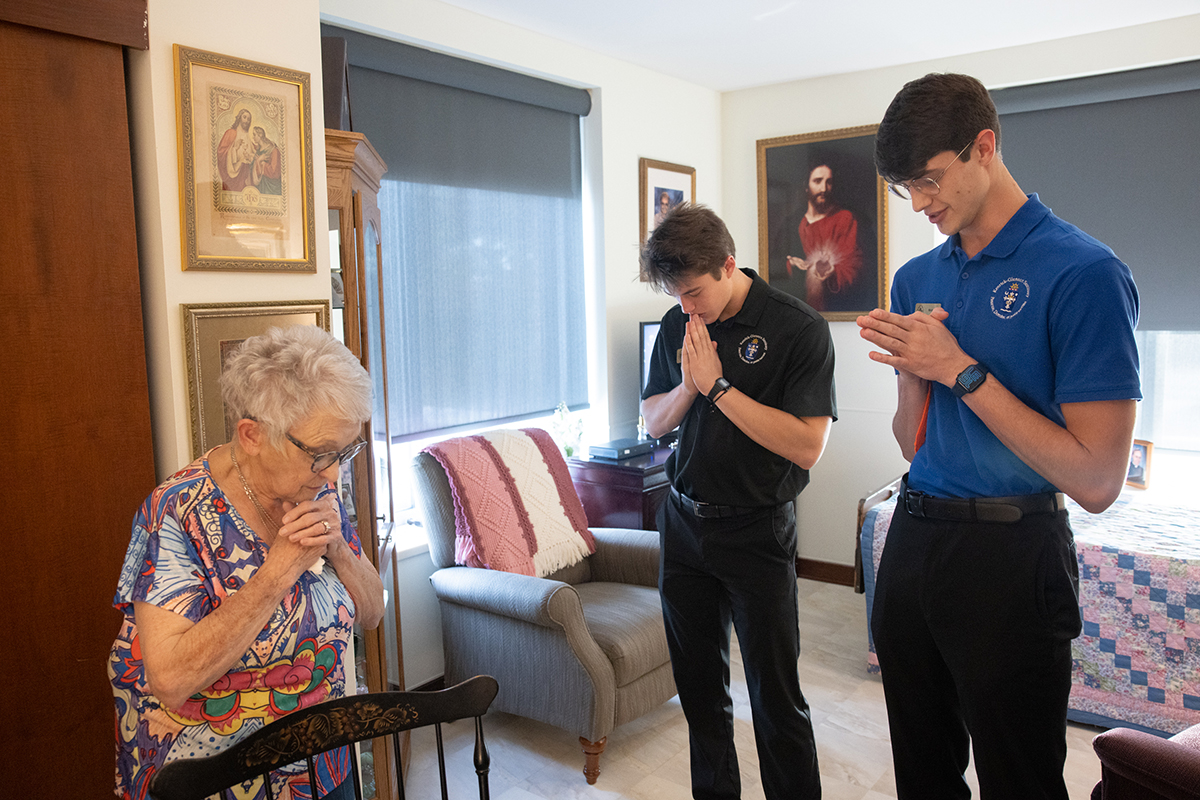Memento mori is an ancient practice of remembering death — and the joy found in the resurrection

The Christian tradition of remembering our death is a reminder of the hope in the Resurrection.
We have one life. What are we doing with it? Are we remembering our death?
To some it sounds strange, but that’s what a Daughter of St. Paul is doing through her revival of an ancient practice called memento mori — or remembering one’s own inevitable death.
Sister Theresa Aletheia Noble’s new book, “Remember your Death: Memento Mori,” was released by the Daughters of St. Paul in January. Now in its second printing, the Lenten devotional was designed to help others meditate on the moments of their lives and ultimately remember our Christian hope in the Resurrection — made possible through Christ’s victory over sin and death. A companion journal was published last year.
The project came to fruition through doing what the Daughters of St. Paul do best — evangelizing through media. Sister Theresa Aletheia shared her personal reflections on memento mori in a series of tweets after she placed a small skull on her desk as a reminder of her death. What she found was that those tweets — more than 550 over the period of about a year — also struck a nerve with her followers, which now amount to more than 27,000.
Even before she entered the community, Sister Theresa Aletheia learned that the Daughters’ founder, Blessed James Alberione, had kept a skull on his desk as a reminder of his death. “At the time, I thought that’s really metal and cool and I’m going to do that at some point, but I didn’t really understand why he did that,” she said in a phone interview from her convent in Boston. She tucked away the idea in the back of her mind during religious formation, vowing to follow up on it.
In the fall of 2017, another sister in the community gave Sister Theresa Aletheia a small ceramic skull to place on her desk. To keep her promise to reflect on death, she decided to share some reflections on Twitter using the hashtag #mementomori.
“As I was doing it, I was feeling this monumental shift in my spiritual life,” she said. Others were finding the same, too, as evidenced through messages she received. One man wrote to her about how he was suffering from insomnia and feeling overworked at his job. He read one of her tweets that included a passage from Scripture. The man told her it inspired him to go back to church. The first day he walked into church, he heard the priest citing the same Scripture passage that Sister Theresa Aletheia referenced.
“I thought, God is doing something in my life, and He’s doing something through other people’s lives, too, so I’m going to continue to do this,” she said.
The devotional, which guides the reader through Lent, includes daily Scripture passages, Lenten meditations, memento mori-themed examinations, intercessory prayers and prompts for journaling and prayer. In the introduction, Sister Theresa Aletheia noted that through the triumph of the cross, remembering our death involves not just considering one’s own mortality, but Christ’s victory over death.
“If we belong to the Lord, we need not fear bodily death,” she wrote. “Through His passion, death and resurrection, Jesus has made salvation available to those who choose to enter into Christ’s death, to be buried with Him, and to rise with Him to new life.”
The ancient practice of remembering death “can bring joy, focus and fruitfulness to anyone’s life,” she wrote. “However, for the Christian, it is a practice that extends beyond the reality of earthly life and bodily death. In the power of Jesus Christ, the Christian practice of memento mori reaches past the horizon of this life and into the eternal happiness of heaven.”
The feedback she’s received from the devotional as well as her posts on social media have come from a variety of ages and backgrounds, she said. But she’s definitely noticed a reach to a younger audience, thanks to her interactions on Twitter and Instagram.
The practice of memento mori was popularized in medieval times, but in reality dates back to early Christianity, as evidenced through Scripture. One of Sister Theresa Aletheia’s favorite passages is from the Book of Sirach, which states: “in whatever you do, remember your last days, and you will never sin” (Sirach 7:36). In the New Testament, Jesus reminded the disciples to pick up their crosses daily and to remember their death as they follow Him: “If anyone wishes to come after Me, he must deny himself and take up his cross daily and follow Me” (Luke 9:23).
In that passage, “He was foreseeing how He was going to transform death. That is an exhortation from Jesus to remember death,” she said. “The difference for the Christian is not only remembering our own personal death — there is an end to this life — but Jesus has transformed our death.”
Lent is an obvious time to reflect on death, which is why she decided to create a devotional, rather than writing a book. “The devotional brings people day by day,” she said. “St. Benedict said to keep death before your eyes daily. Lent is a time when people are willing to do that. I’m so excited to start Lent, with something that fills me with joy.
>> Why the skull?

Focusing on the image of a skull as a reminder of our death can be uncomfortable for some people. Sister Theresa Aletheia Noble acknowledged that sentiment in some of the feedback she’s received from people who say they feel it represents an unhealthy view of death.
The Daughter of St. Paul noted that feeling of discomfort stems from a secular culture that has distorted the image over time, reducing it to a negative image associated with things contrary to Christianity. Through the practice of memento mori — remembering one’s inevitable death and the ultimate joy found in the resurrection — Sister Theresa Aletheia said she’s hopeful that this will be an opportunity to reclaim what originally has been a Christian symbol.
“Bones have a different meaning in light of the resurrection,” she recently tweeted.
The image of the skull also has been represented in Christian art for centuries, most notably among depictions of the saints, including St. Jerome, St. Aloysius, St. Mary Magdalene and St. Francis, all of whom used images of skulls and other memento mori items as part of their spiritual reflection.
The Catechism of the Catholic Church teaches that “Death is the end of earthly life. Our lives are measured by time, in the course of which we change, grow old and, as with all living beings on earth, death seems like the normal end of life. That aspect of death lends urgency to our lives: remembering our mortality helps us realize that we have only a limited time in which to bring our lives to fulfillment (CCC 1007).
There also are numerous churches made of bones found throughout Europe, most notably the Capuchin Crypt under the church of Santa Maria della Concezione dei Cappuccini in Rome. Built in the 16th century, the crypt includes the skeletal remains of 3,700 bodies believed to be Capuchin friars. The order has displayed the bones as a reminder of human mortality.
“Some people are shocked and find it disturbing and weird,” Sister Theresa Aletheia said. “But the people who did it didn’t think of it that way. Our view of death has de-Christianized over time. I think it’s strange if we can’t look at a skull and see resurrection in it. When people say they are shocked … that means the meditation on death would be helpful for that.”
The Catechism also notes that the Church “firmly believes and confesses that on the Day of Judgment all men will appear in their own bodies before Christ’s tribunal to render an account of their own deeds. At the end of time, the Kingdom of God will come in its fullness. Then the just will reign with Christ for ever, glorified in body and soul, and the material universe itself will be transformed. God will then be ‘all in all’ (1 Corinthians 15:28), in eternal life” (CCC 1059-60).
The Church also encourages us to prepare for the hour of death. Every action, every thought should be focused on the possibility that death could come at any moment in time. “Death would have no great terrors for you if you had a quiet conscience … Then why not keep clear of sin instead of running away from death? If you aren’t fit to face death today, it’s very unlikely you will be tomorrow …” (CCC 1014)
>> Read more
To purchase a copy of “Remembering Your Death: Memento Mori,” visit Pauline Books & Media, 9804 Watson Road in Crestwood. A companion journal also is available.
Other reading resources include:
• “Life out of Death: Meditations on the Paschal Mystery,” by Hans Urs Von Balthasar
• “The Defence of Skeletons,” an essay by G.K. Chesterton, which is included in “The Defendant,” a collection of his essays
>> Follow online
Sister Theresa Aletheia Noble, FSP, is on Twitter and Instagram at @pursuedbytruth. Also be sure to follow the hashtag #mementomori on Twitter and Instagram.
The Pope and the American Bishops have outlined obligatory fast and abstinence as follows:
Ash Wednesday (Wednesday March 6, 2019) and Good Friday (April 19, 2019) are days of abstinence for all Catholics over the age of 14. On these two days, fast, as well as abstinence, is also obligatory for those from the ages of 18-59. Abstinence means refraining from meat. Fast means one full meal a day, with two smaller meals and nothing between meals (liquids are permitted). No Catholic will lightly excuse himself or herself from this obligation.
All Fridays in Lent are days of abstinence from meat. Here again Catholics will not hold themselves lightly excused, but if there is a serious health problem, this obligation would not apply.
We should strive to make all days of Lent a time of prayer and penance. Following are several resources that can aid in finding different forms of prayer and penance.
>> Lenten resources
Read Pope Francis’ Lenten message at bit.ly/2EfkGyc
USCCB Lent page: https://bit.ly/1AmYycZ
St. Louis Review Lenten resources and fish fry map at archstl.org/lent
We have one life. What are we doing with it? Are we remembering our death? To some it sounds strange, but that’s what a Daughter of St. Paul is doing … Memento mori is an ancient practice of remembering death — and the joy found in the resurrection
Subscribe to Read All St. Louis Review Stories
All readers receive 5 stories to read free per month. After that, readers will need to be logged in.
If you are currently receive the St. Louis Review at your home or office, please send your name and address (and subscriber id if you know it) to subscriptions@stlouisreview.com to get your login information.
If you are not currently a subscriber to the St. Louis Review, please contact subscriptions@stlouisreview.com for information on how to subscribe.







